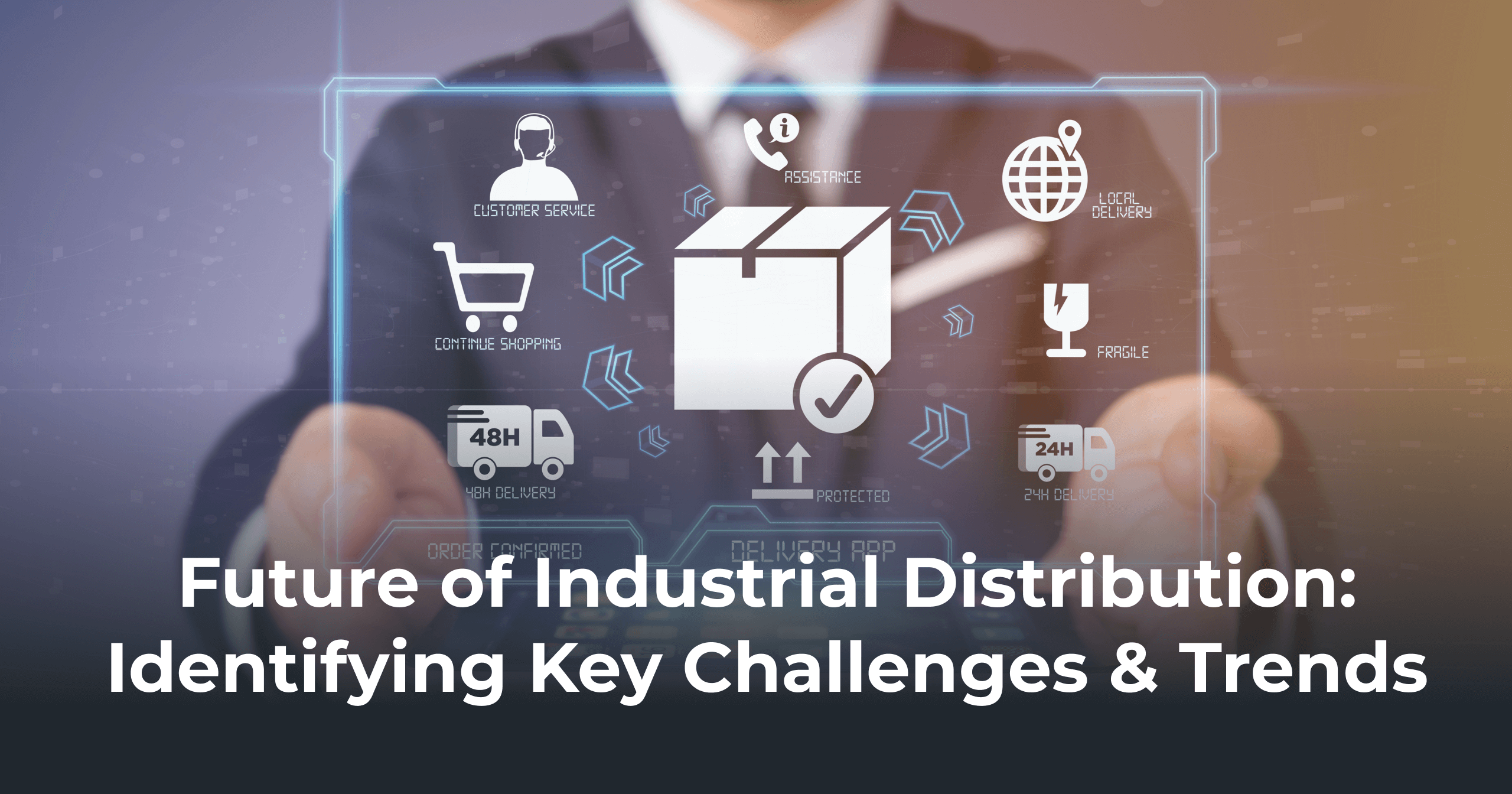The unprecedented pandemic brought many radical changes in the distribution industry. Challenges came all along the path. You might have faced uncertain demand, increasing strain on customer relationships, supply chain interruptions, and a pressing need to protect the workers during the COVID-19 epidemic.
We also witnessed many businesses withering away. However, that was a pause but not a full stop. The pandemic taught industrialdistributors across the globe the need for agile technologies and integrated solutions to eliminate working in silos and build agility.
Amid the large-scale shift to remote work culture and limited in-house operation, you need robust technology to enhance core capabilities, streamline processes, eliminate manual errors, and build new client experiences quicker and more flexibly.
Contents
Understanding the Pain Points in The Industrial Distribution Sector

1. Increasing Competition & Changing Market
The market dynamics are changing. Companies that are focusing on improving customer loyalty need to identify market demand, consumer choice and should invest in technology that meets business goals and enhances the consumer experience.
Suppliers, neighboring industry participants, and marketplaces are becoming more competitive. These unconventional rivals are using technology to monopolize industrial distribution sector and capitalize on growing markets such as B2B e-commerce.
With the advancement in the omnichannel market, B2B customers have ample opportunities to choose from solutions that offer competitive pricing and delivery options. The increasing competition necessitates you to find a new revenue stream and invest in integrated solutions that help to ace transparency and automation in business operations.
2. Fluctuating Global Supply Chain Dynamics
When manufacturing slowed down due to pandemic, many industrial distribution leaders faced disruption in adding value to the supply chain demands. With new market rivals and technology disruptions, it would be difficult for you to survive in the digital market without advanced strategies.
Digital entrants aren’t the only ones facing competition. Traditional distributors are also being challenged by big-box retailers, who are utilizing their analytical expertise and consumer data to build customized value propositions for customers.
According to Chip Kleinheksel, Principal at Deloitte Consulting, moving forward, distributors must have a better optimization tactic to plan inventory, manage inventory, and estimate the demand that will be coming their way.
Today in the post-pandemic world, retailers are reimagining distribution. To retain market value, you need to create transparency in the entire business operations. It’s time for you to hone your competitive edge and restructure your planning & forecasting, channel revenue management, warehousing, and logistics using advanced technology.
As McKinsey report states,
Over 60% of US shoppers had encountered out-of-stock products in the previous three months, and just 13% of those who did so waited for the item to return, while 39% switched brands.
3. Need for Advanced Analytics Capabilities
Leaders are 72% more likely to have business analytics integrated into ERP, which means they can make better decisions backed up with evidence and perform more accurate demand planning. -Asavin Wattanajantra, Sage Software

Data Analytics plays a major role in enhancing the industrial distribution sector. The right information at the right time is the key to boosting agility. Supply chain infrastructure with a lack of data and visibility affects customer satisfaction. It results into
- Complex demand planning
- Unoptimized inventory management
- Fragmented data influx
- Lengthier decision making & execution process
One of the biggest challenges distributors face while dealing with the management & movement of goods is establishing a real-time connection across departments. Without integrated solutions, you are going to face difficulty in managing enterprise resources and data in omnichannel eCommerce. A centralized data source is crucial to channelize workflow in every enterprise.
4. Fragmented Customer-Distributor Interactions
It’s no wonder that new-age clients want everything to be faster, cheaper, and better in a world supposedly run by iPhones and Amazon. This drive for immediate satisfaction has now made its way into the B2B sector, and most distributors understand that they must keep up maintaining client connections through tailored services and pricing.
However, streamlining customer journeys is one of the biggest challenges distributors face in a fragmented environment. Though there are ample touchpoints to improve the experience, the siloed operations restrict employees in various departments from gaining meaningful data to understand customer behavior and enhance user experience.
5. Inefficiency in Profit Margin Improvement
Many wholesalers and distributors are finding it difficult to compete in an increasingly digital environment and improve profit margins. Lack of resources, rising D2C markets, new consumer behavior, and digital capabilities might be restricting you from achieving competitive advantages through pricing. Also, distributors are pressurized by manufacturers seeking more efficiency and customers wanting omnichannel experiences at the lowest possible price. The current time demands investment in growth and differentiation. It’s the right time to offer new value-added services to build market share and leap ahead.
Big data, smart analytics tools, and tremendous digital capabilities are fueling a revolution in pricing. In an organization where margins are razor-thin, the pricing capacity is vital. Distributors who implement end-to-end pricing changes and digital transformation can increase profits by up to 50% while having little or no impact on volume. Amidst the rising D2C landscape, stellar digital capabilities are crucial to understanding your customer and adjusting pricing to each client and scenario.
6. Disorganized Industrial Consolidation
For years, the industrial distribution marketplace has been highly fragmented, and the pandemic has exposed the unorganized landscape even more. Companies with advanced technology, such as solid e-commerce platforms, robust ERP systems, and effective digital channel deployment, have become more valuable than companies with less advanced technology.
Industrial Distribution sector, on the other hand, cannot prosper to their full potential unless their operations are unified. Even in this digital age, the industrial distribution industry is still made up of a large number of small businesses. According to reports, even the largest player in most areas of industrial distribution accounts for no more than 6% of the whole market.
The moment has come for distributors to come together as a cohesive force. By moving your focus away from incremental acquisitions, every distributor should focus on merging with transformational/ strategic M&A (Merger & Acquisition) players.
7. Fragmented Legacy IT Systems
Many distributors are still using the old fragmented legacy system to support retail operations. But as operations expand within the company, such as the implementation of novel workflows or software and hardware, things get more sophisticated (Yes, of course, it is functional but not scalable enough to help you expand) and upkeep becomes more expensive.
The introduction of smartphones and the cloud has undoubtedly changed the way people work, resulting in the creation of new workflows. Old systems may not fit into modern processes in many circumstances, or user behavior may deem legacy apps outdated. Moreover, lacking regular maintenance, legacy systems with vulnerabilities will notify the updates and patches necessary to stay secure in the modern world. Poor data security presents a risk to distributors working in the old legacy system.
Heading Towards the Future: What Industrial Distributors Need to Look Forward to?
If you ignore industry changes, your supply chain might soon lag behind your competitors. Customers’ purchasing patterns have shifted drastically in recent years, making distributors adopt smart technology integrated solutions to survive in the digital race. Tracking what has already changed and what will happen in the future will keep the business relevant and equipped to prosper in the coming years.

Here are top trends every distributor should look forward to for bringing productivity & efficiency:
1. Workflow Automation
To gain a competitive advantage in today’s marketplace, every distributor needs an automated solution that accelerates efficient data flow within the organization across departments. Workflow automation reduces manual errors, saves time, and speeds up the time to market.
2. Cash Flow Management & Revenue Diversification
Bringing visibility is critical if you are planning to streamline cash flow. Increasing sales is not the only way to improve sales. Focus on revenue diversification. Integrating your eCommerce with an ERP solution will help you improve cash flow and reduce overhead spent on manual tasks.
Read More: ERP INTEGRATED SOLUTIONS: BOOST BUSINESS AGILITY & VISIBILITY
- Integrating CRM tools and other vendor data into your ERP system will strengthen your relationship with suppliers. Having all of the necessary data at your fingertips helps you to find cost-cutting opportunities.
- A robust ERP integrated platform ensures inventory control and forecasting features that will help you automatically monitor stock levels and movement. And you can reduce the amount of money you spend on the excess stock with optimized reorder quantities.
3. Unified Experience Across Channels
An omnichannel ERP simplifies both online and offline purchasing experiences for customers and businesses by unifying all processes and data. Robust and scalable ERP integraton solution helps distributors provide compelling experience across multiple sales channels by providing a centralized management system.
According to a McKinsey report,
Customers are purchasing across numerous channels and looking for 24/7 customer support, a full e-commerce website, order monitoring, and real-time inventory management. And the statistics claim Customers are expected to make 30% more of their purchases from distributors via online means; those in the electrical segment expect a 50% increase.
Recommended Reading: AN OVERVIEW OF BUSINESS IMPLICATIONS OF ERP ECOMMERCE INTEGRATION
Towards A Connected Business Ecosystem
Digitization and market automation are constantly evolving. The business mindset is evolving. We are heading towards a customer-first approach, and the best technology deployment is the key to enhancing the user experience. It’s no more practical to work in the old legacy system that consumes time and delays reaching your market goals. Today’s dynamic market demands integrated technology solutions. It’s time to adopt forward-looking ERP integration solutions to cut downtime and speed up your time to market.
Want to know more about integrated solutions for eCommerce? Get in touch with our experts to streamline hassle-free integration.




